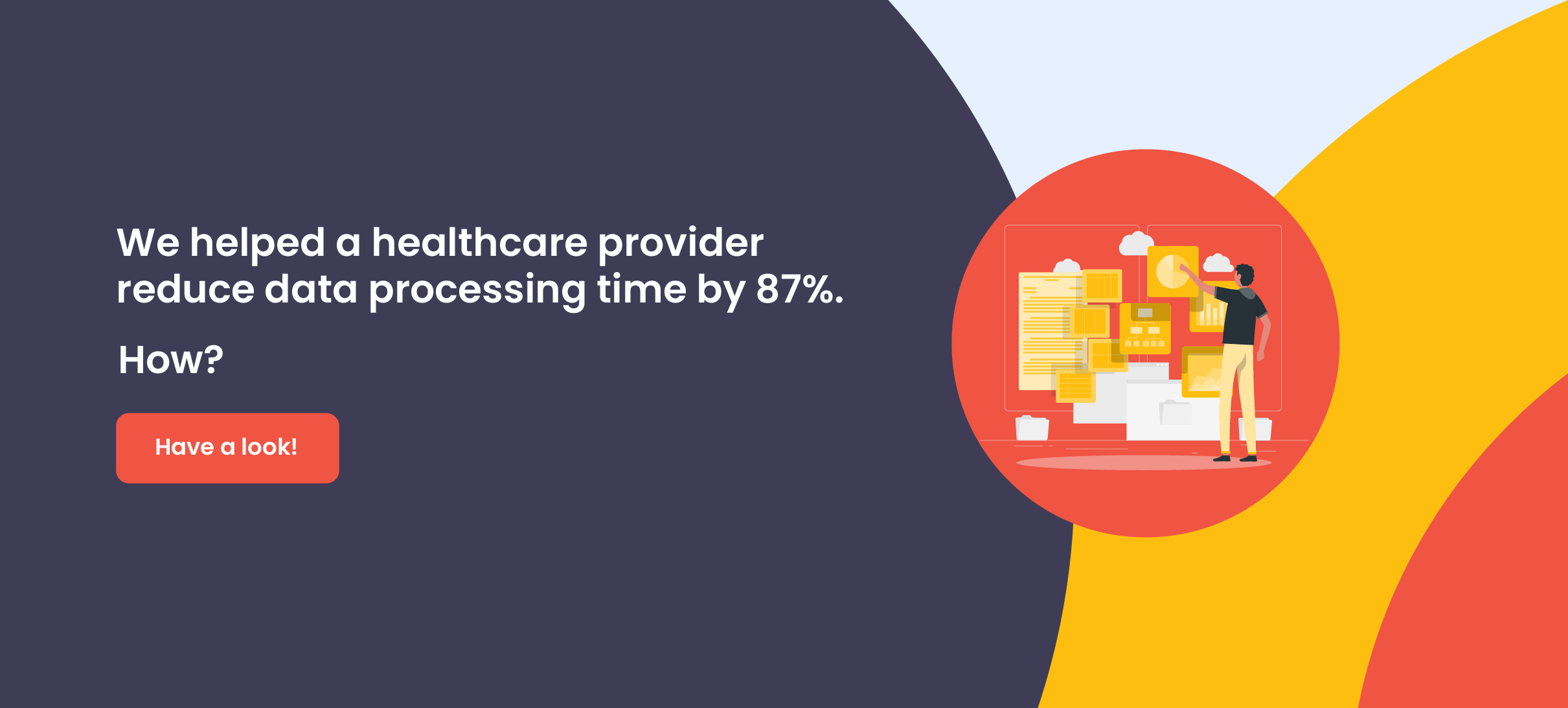NLP in Healthcare: Top Use Cases, Projects & Real-World Examples
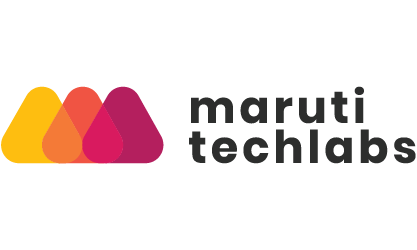 Maruti Techlab
Maruti Techlab
Boost healthcare opportunities by leveraging the power of natural language processing.
Introduction
Natural Language Processing (NLP) is rapidly transforming the healthcare industry, enabling providers to extract actionable insights from unstructured data such as clinical notes, patient feedback, and medical literature.
Natural Language Processing (NLP) is rapidly transforming the healthcare industry, enabling providers to extract actionable insights from unstructured data such as clinical notes, patient feedback, and medical literature.
This is precisely why we made a short video on the topic. It is less than 2 mins, and summarizes top 14 Use Cases of Natural Language Processing in Healthcare. We hope this helps you learn more and save your time. Cheers!
Published by MarketsandMarkets, the market size for NLP in healthcare & life sciences is expected to significantly increase from USD 5.18 billion in 2025 to USD 16.01 billion by 2030 at a CAGR of 25.3%
This surge is driven by increased digitization of medical records, AI adoption in clinical workflows, and the need to improve patient outcomes through intelligent automation. From automating administrative tasks to detecting early signs of disease through EHR analysis, NLP is empowering healthcare systems to become more efficient, accurate, and patient-centric.
In this blog, we’ll explore the top NLP use cases in healthcare, real-world implementations by leading institutions, and cutting-edge projects shaping the future of medical AI. Whether you're a provider, technologist, or researcher, these insights can help you navigate NLP’s expanding role in healthcare.
What is NLP in Healthcare?
The NLP illustrates the manners in which artificial intelligence policies gather and assess unstructured data from the language of humans to extract patterns, get the meaning and thus compose feedback. This is helping the healthcare industry to make the best use of unstructured data. This technology facilitates providers to automate the managerial job, invest more time in taking care of the patients, and enrich the patient’s experience using real-time data.
However, NLP applications in healthcare go beyond understanding human language.
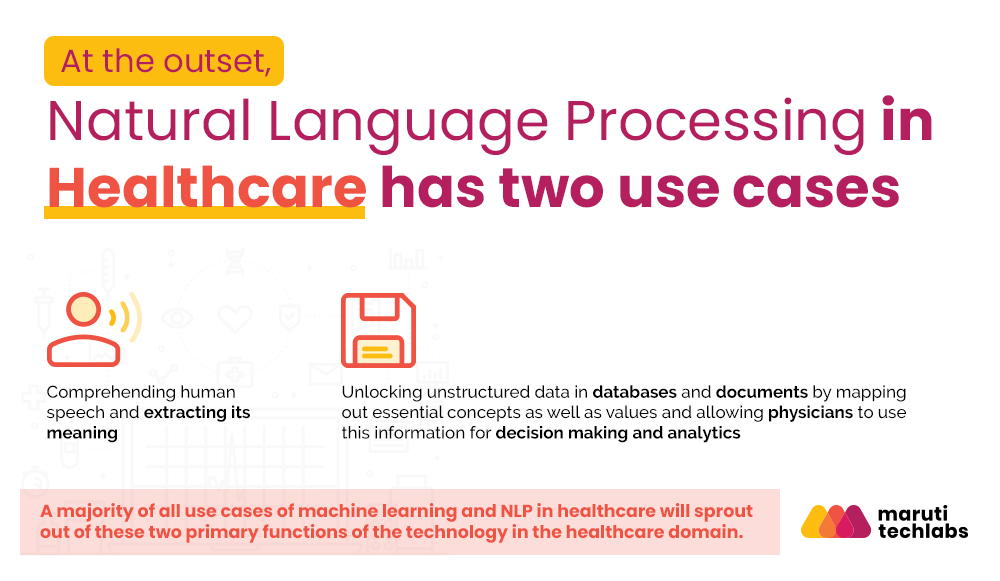
You will be reading more in this article about the most effective uses and role of NLP in healthcare corporations, including benchmarking patient experience, review administration and sentiment analysis, dictation and the implications of EMR, and lastly the predictive analytics.
Who’s Adopting NLP in Healthcare?
Natural Language Processing (NLP) is increasingly being adopted across the healthcare industry, with various organizations leveraging its capabilities to enhance operations and patient care.
- Healthcare Providers and Hospitals: Renowned healthcare institutions in the USA are utilizing NLP to automate administrative tasks, improve clinical documentation, and streamline patient flow management.
- Technology Companies: Major tech firms such as Amazon, Google, and Microsoft are integrating NLP into their healthcare solutions. For instance, Amazon's HealthScribe analyzes doctor-patient conversations to create clinical notes, while Google's MedLM summarizes patient-doctor interactions and automates insurance claims processing.
- Pharmaceutical and Life Sciences Companies: Organizations like Genentech and AstraZeneca employ NLP for drug discovery research and clinical trial tasks, utilizing AI tools to analyze vast datasets efficiently.
- Government and Research Institutions: Entities such as the U.S. Food and Drug Administration (FDA) collaborate with companies like John Snow Labs to leverage NLP to understand medicines' effects on large populations.
The adoption of NLP in healthcare is driven by the need to process unstructured data, enhance clinical decision-making, and improve operational efficiency, reflecting a significant shift towards AI-driven healthcare solutions.
4 Real World Examples of NLP in Healthcare
Natural Language Processing is no longer just a promising concept in healthcare. It’s already delivering tangible results through innovative applications by leading organizations.
From enhancing clinical documentation to supporting diagnostic decisions, NLP is helping providers unlock insights from vast amounts of unstructured medical data.
Let’s examine how companies like Epic Systems, Nuance, Google, and IBM are making a tangible impact in healthcare with NLP-powered solutions.
1. Epic Systems: NLP for Clinical Notes
Epic Systems integrates NLP into its electronic health records (EHR) platform to analyze unstructured clinical notes. This enables physicians to quickly extract key patient information, identify trends, and support decision-making.
By converting free-text data into structured insights, Epic enables healthcare providers to reduce administrative burdens and enhance care delivery efficiency across large hospital networks.
2. Nuance’s Dragon Medical One
Nuance’s Dragon Medical One is a cloud-based speech recognition solution that leverages NLP to transcribe physician-patient conversations in real-time. It allows clinicians to create comprehensive clinical documentation hands-free, reducing burnout and improving accuracy.
Widely adopted in over 10,000 healthcare facilities, it’s transforming workflows by enabling faster and more efficient medical record-keeping.
3. Google’s Med-PaLM
Google’s Med-PaLM is an advanced large language model trained specifically on medical datasets to answer complex healthcare questions with high accuracy.
Tested by physicians, it shows potential in assisting with diagnostics, providing evidence-based recommendations, and enhancing patient education. Med-PaLM represents Google’s push to create safer, more reliable AI tools for clinical use.
4. IBM Watson: Oncology Projects
IBM Watson has been deployed in oncology to help physicians develop personalized treatment plans for cancer patients. By analyzing vast amounts of medical literature, patient records, and clinical trial data, Watson provides evidence-backed recommendations.
Although facing challenges in scalability, Watson’s oncology tools have helped clinicians globally accelerate research and enhance treatment precision.
Top 14 Use Cases NLP in Healthcare
Let us have a look at the 14 use cases associated with NLP in Healthcare:
1. Clinical Documentation
NLP healthcare systems help free clinicians from the laborious physical systems of EHRs and permits them to invest more time in the patient; this is how NLP can help doctors. Both speech-to-text dictation and formulated data entry have been a blessing. The Nuance and M*Modal consists of technology that functions in team and speech recognition technologies for getting structured data at the point of care and formalised vocabularies for future use
The NLP technologies bring out relevant data from speech recognition equipment which will considerably modify analytical data used to run VBC and PHM efforts. This has better outcomes for the clinicians. In upcoming times, it will apply NLP tools to various public data sets and social media to determine Social Determinants of Health (SDOH) and the usefulness of wellness-based policies.
2. Speech Recognition
NLP has matured its use case in speech recognition over the years by allowing clinicians to transcribe notes for useful EHR data entry. Front-end speech recognition eliminates the task of physicians to dictate notes instead of having to sit at a point of care, while back-end technology works to detect and correct any errors in the transcription before passing it on for human proofing.
This advancement significantly contributes to EHR NLP, optimizing electronic health records by converting spoken language into structured data.
The market is almost saturated with speech recognition technologies, but a few startups are disrupting the space with deep learning algorithms in mining applications, uncovering more extensive possibilities.
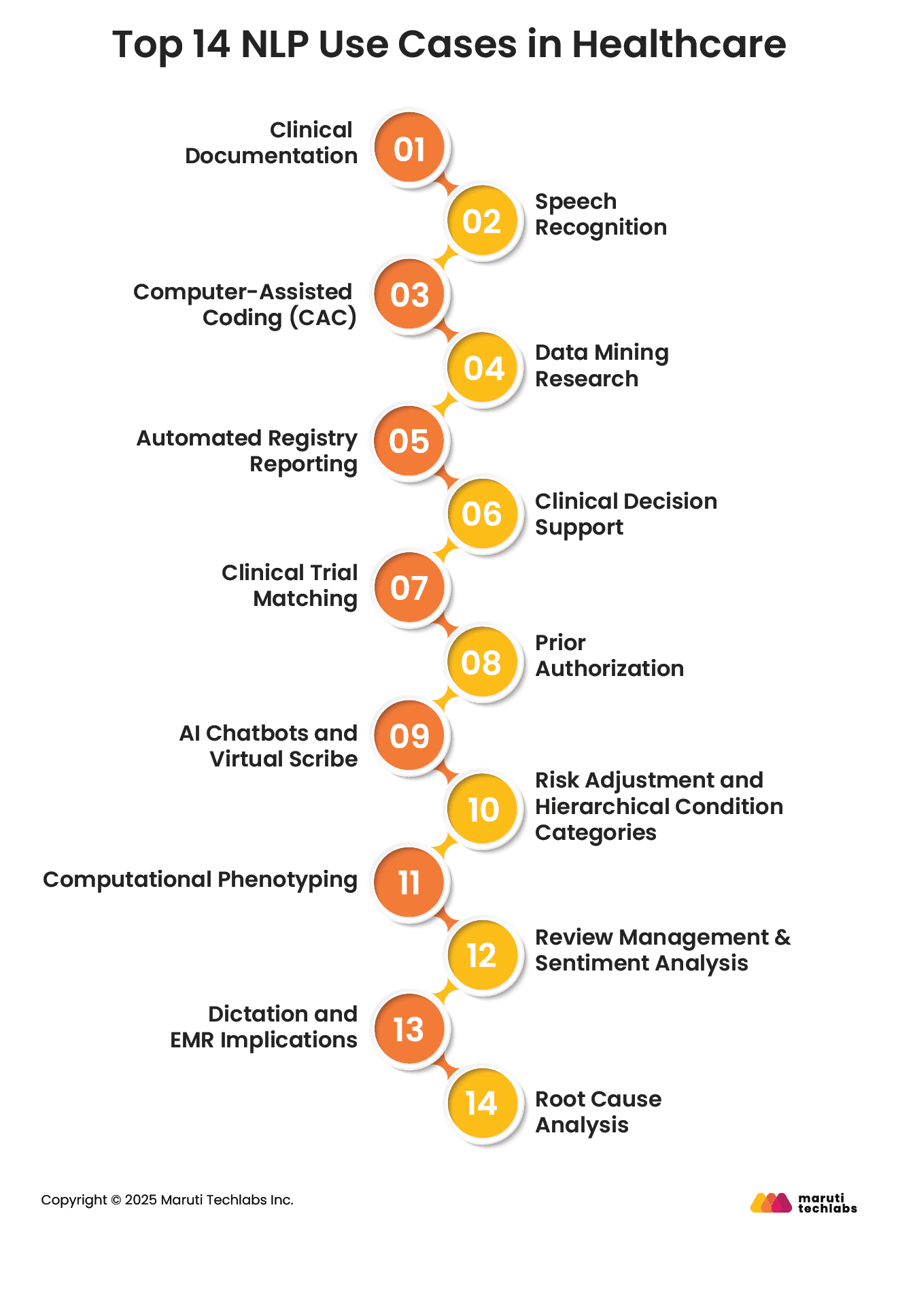
3. Computer-Assisted Coding (CAC)
Computer-assisted coding (CAC) is one of the most famous examples of NLP applications in healthcare. This is a direct application of medical coding with NLP, where natural language processing techniques are employed to assign accurate medical codes, streamlining the billing process. CAC captures data of procedures and treatments to grasp each possible code to maximize claims. It is one of the most popular uses of NLP, but unfortunately, its adoption rate is just 30%. It has enriched the speed of coding but fell short at accuracy.
4. Data Mining Research
The integration of data mining, healthcare technology, and big data analytics in healthcare systems allows organizations to reduce the levels of subjectivity in decision-making and provide useful medical know-how. Once started, data mining can become a cyclic technology for knowledge discovery, which can help any HCO create a good business strategy to deliver better care to patients.
5. Automated Registry Reporting
An NLP use case is to extract values as needed by each use case. Many health IT systems are burdened by regulatory reporting when measures such as ejection fraction are not stored as discrete values. For automated reporting, health systems will have to identify when an ejection fraction is documented as part of a note, and also save each value in a form that can be utilized by the organization’s analytics platform for automated registry reporting.
Automated registry reporting can be cumbersome to implement. To achieve the best possible results from the go, we recommend you seek the expertise of Natural Language Processing services.
6. Clinical Decision Support
Advancements in NLP applications in healthcare are poised to elevate clinical decision support. Nonetheless, solutions are formulated to bolster clinical decisions more acutely. There are some areas of processes, which require better strategies of supervision, e.g., medical errors.
According to a report, recent research has indicated the beneficial use of NLP for computerized infection detection. Some leading vendors are M*Modal and IBM Watson Health for NLP-powered CDS. In addition, with the help of Isabel Healthcare, NLP is aiding clinicians in diagnosis and symptom checking.
7. Clinical Trial Matching
NLP applications in healthcare are making significant strides, especially in Clinical Trial Matching.
Using NLP and machines in healthcare for recognising patients for a clinical trial is a significant use case. Some companies are striving to answer the challenges in this area using Natural Language Processing in Healthcare engines for trial matching. With the latest growth, NLP can automate trial matching and make it a seamless procedure.
One of the use cases of clinical trial matching is IBM Watson Health and Inspirata, which have devoted enormous resources to utilize NLP while supporting oncology trials.
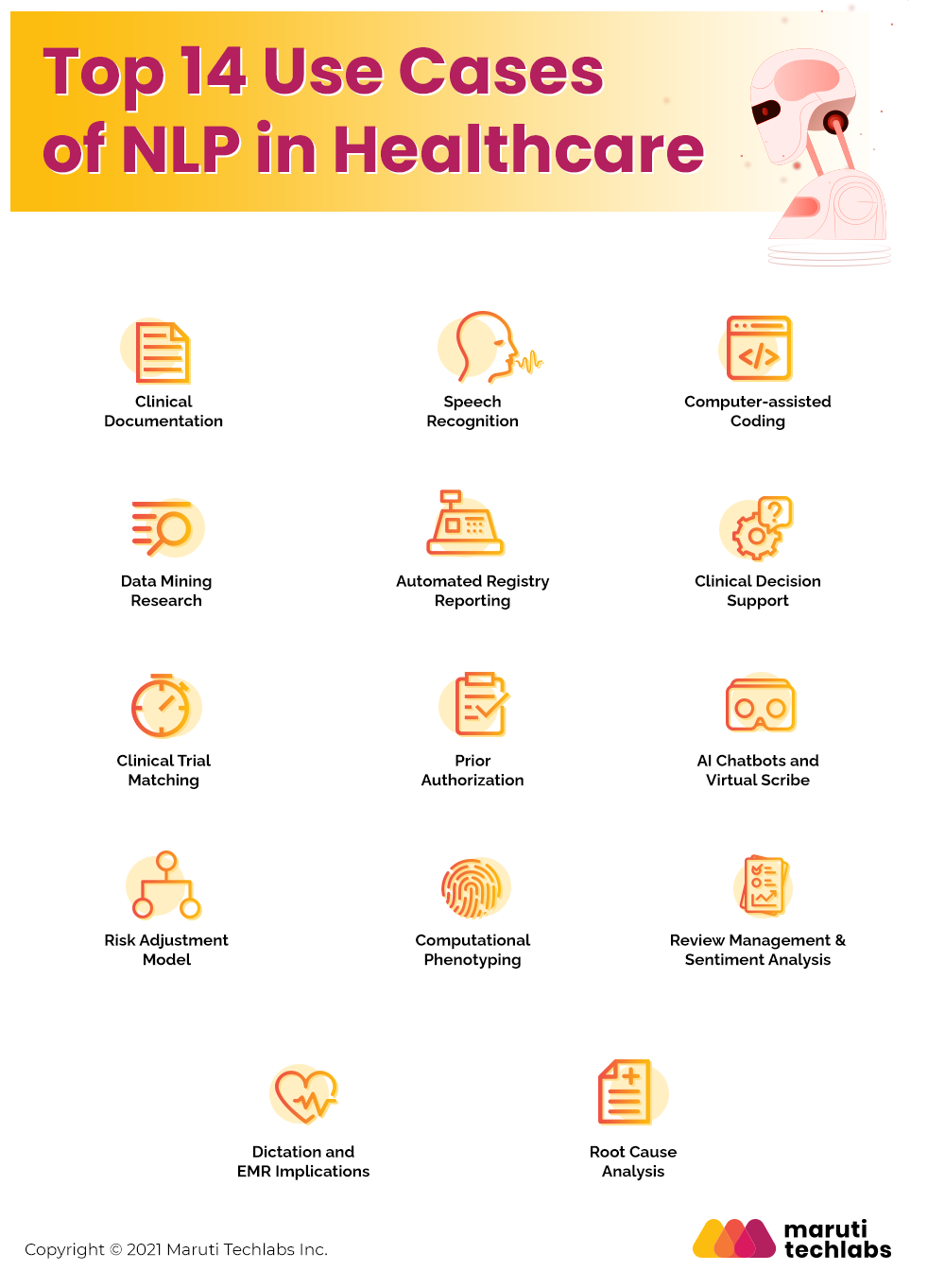
8. Prior Authorization
Analysis has demonstrated that payer prior authorisation requirements on medical personnel are just increasing. These demands increase practice overhead and holdup care delivery. The problem of whether payers will approve and enact compensation might not be around after a while, thanks to NLP. IBM Watson and Anthem are already up with an NLP module used by the payer’s network for deducing prior authorisation promptly.
9. AI Chatbots and Virtual Scribe
Although no such solution exists presently, the chances are high that speech recognition apps would help humans modify clinical documentation. The perfect device for this will be something like Amazon’s Alexa or Google’s Assistant. Microsoft and Google have tied up for the pursuit of this particular objective. Well, thus, it is safe to determine that Amazon and IBM will follow suit.
Chatbots or Virtual Private assistants exist in a wide range in the current digital world, and the healthcare industry is not out of this. Presently, these assistants can capture symptoms and triage patients to the most suitable provider. New startups formulating chatbots comprise BRIGHT.MD, which has generated Smart Exam, “a virtual physician assistant” that utilises conversational NLP to gather personal health data and compare the information to evidence-based guidelines along with diagnostic suggestions for the provider.
Another “virtual therapist” started by Woebot connects patients through Facebook messenger. According to a trial, it has gained success in lowering anxiety and depression in 82% of the college students who joined in.
10. Risk Adjustment and Hierarchical Condition Categories
Hierarchical Condition Category coding, a risk adjustment model, was initially designed to predict the future care costs for patients. In value-based payment models, HCC coding will become increasingly prevalent. HCC relies on ICD-10 coding to assign risk scores to each patient. Natural language processing can help assign patients a risk factor and use their score to predict the costs of healthcare.
11. Computational Phenotyping
In many ways, the NLP is altering clinical trial matching; it even had the possible chances to help clinicians with the complicatedness of phenotyping patients for examination. For example, NLP will permit phenotypes to be defined by the patients’ current conditions instead of the knowledge of professionals.
To assess speech patterns, it may use NLP that could validate to have diagnostic potential when it comes to neurocognitive damages, for example, Alzheimer’s, dementia, or other cardiovascular or psychological disorders. Many new companies are ensuing around this case, including BeyondVerbal, which united with Mayo Clinic for recognising vocal biomarkers for coronary artery disorders. In addition, Winterlight Labs is discovering unique linguistic patterns in the language of Alzheimer’s patients.
12. Review Management & Sentiment Analysis
NLP can also help healthcare organisations manage online reviews. It can gather and evaluate thousands of reviews on healthcare each day on 3rd party listings. In addition, NLP finds out PHI or Protected Health Information, profanity or further data related to HIPPA compliance. It can even rapidly examine human sentiments along with the context of their usage.
Some systems can even monitor the voice of the customer in reviews; this helps the physician get a knowledge of how patients speak about their care and can better articulate with the use of shared vocabulary. Similarly, NLP can track customers’ attitudes by understanding positive and negative terms within the review.
13. Dictation and EMR Implications
On average, EMR lists between 50 and 150 MB per million records, whereas the average clinical note record is almost 150 times extensive. For this, many physicians are shifting from handwritten notes to voice notes that NLP systems can quickly analyse and add to EMR systems. By doing this, the physicians can commit more time to the quality of care.
Much of the clinical notes are in amorphous form, but NLP can automatically examine those. In addition, it can extract details from diagnostic reports and physicians’ letters, ensuring that each critical information has been uploaded to the patient’s health profile.
14. Root Cause Analysis
Another exciting benefit of NLP is how predictive analysis can give the solution to prevalent health problems. Applied to NLP, vast caches of digital medical records can assist in recognising subsets of geographic regions, racial groups, or other various population sectors which confront different types of health discrepancies. The current administrative database cannot analyse socio-cultural impacts on health at such a large scale, but NLP has given way to additional exploration.
In the same way, NLP systems are used to assess unstructured response and know the root cause of patients’ difficulties or poor outcomes.
What Immediate Benefits Can Healthcare Organizations Get By Leveraging NLP?
Healthcare organizations can use NLP to transform how they deliver care and manage solutions. Organizations can use machine learning in healthcare to improve provider workflows and patient outcomes.
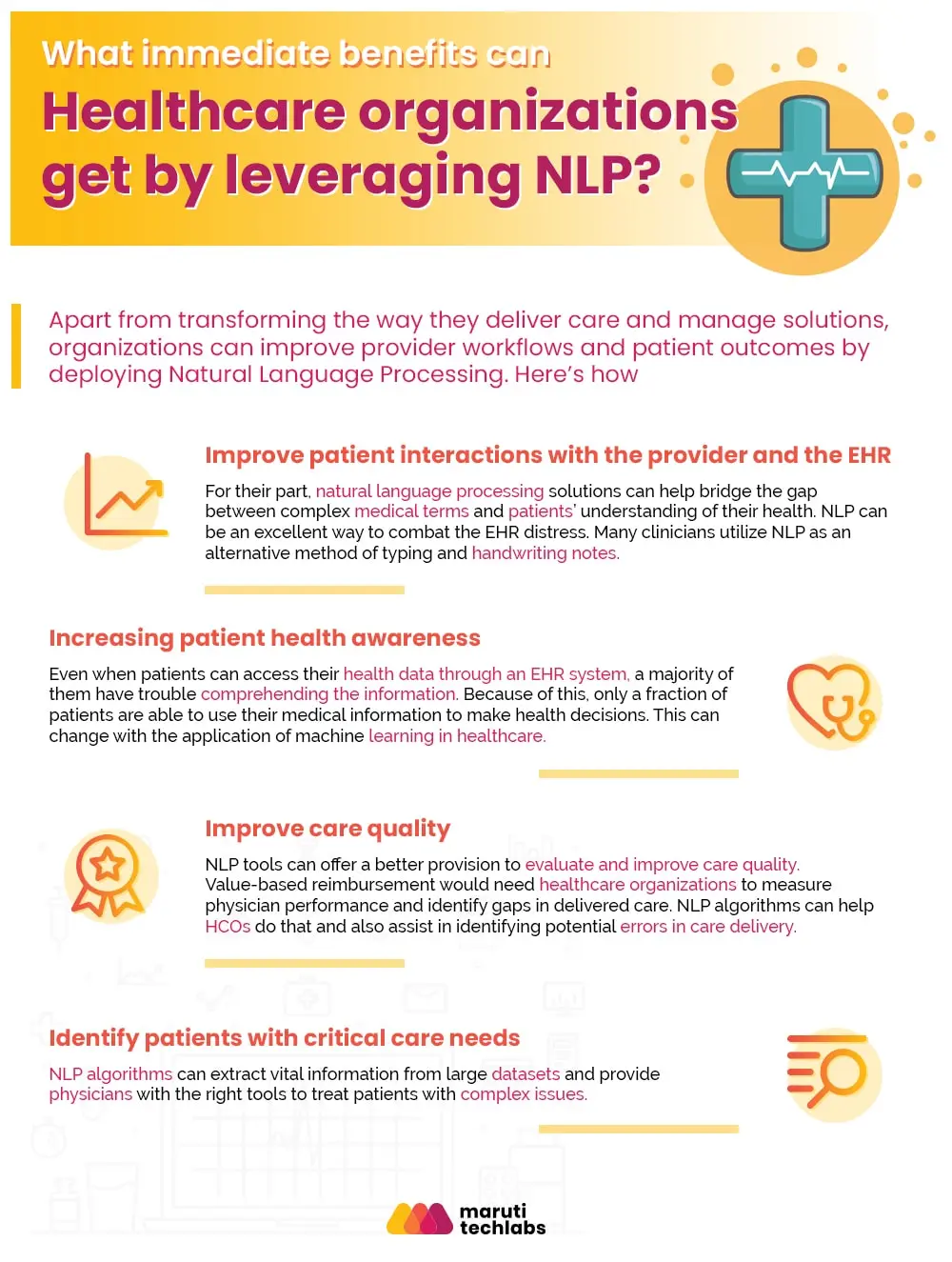
Here is a wrap-up of the use of Natural Language Processing in healthcare:
1. Improve Patient Interactions With the Provider and the EHR
Natural language processing solutions can help bridge the gap between complex medical terms and patients’ understanding of their health. NLP can be an excellent way to combat EHR distress. Many clinicians utilize NLP as an alternative method of typing and handwriting notes.
2. Increasing Patient Health Awareness
Most need help comprehending the information even when patients can access their health data through an EHR system. Because of this, only a fraction of patients can use their medical information to make health decisions. This can change with the application of machine learning in healthcare.
3. Improve Care Quality
NLP tools can offer better provisions for evaluating and improving care quality. Value-based reimbursement would require healthcare organizations to measure physician performance and identify gaps in delivered care. NLP algorithms can help HCOs do that and also assist in identifying potential errors in care delivery.
4. Identify Patients With Critical Care Needs
NLP algorithms can extract vital information from large datasets and provide physicians with the right tools to treat complex patient issues.
How can Doctors Benefit by Implementing NLP in Healtcare Projects?
A study highlighted that physicians spend as much as 49% of their time on EHRs and desk work. The same survey also revealed that they could devote only 27% of their day towards clinical patient care.
This excessive paperwork burden is touted to be a significant contributor to physician burnout. This not only takes a toll on the well-being of healthcare professionals but also profoundly impacts patient care.
Application of NLP in healthcare projects is emerging as a potential solution to this problem.
Paperwork Reduction and Increased Efficiency: NLP healthcare systems can interpret and record medical information in real-time, eliminating the need for doctors to sit down and make entries manually. This can significantly reduce the paperwork burden, increasing efficiency and allowing healthcare professionals to focus more on patient care.
Real-Time Clinical Data Analysis: Advanced NLP systems can scan vast clinical text data within seconds and extract valuable insights from piles of data. For example, an NLP medical record summarization model can analyze a patient’s medical history within seconds and generate a comprehensive summary highlighting all the essential clinical findings and previous treatments.
Computer-Assisted Coding (CAC): Another advantage of NLP is the ability of computer-assisted coding to synthesize lengthy chart notes into essential pointers. In the past, the manual review and processing of extensive stacks of chart notes from health records stretched for weeks, months, or even years. NLP-enabled systems can significantly expedite this process, accelerate the identification of crucial information, and streamline the overall workflow.
Top 5 Challenges of NLP in Healthcare
While NLP is revolutionizing healthcare, its implementation comes with significant hurdles. From data security concerns to technical complexities, these challenges must be addressed to unlock its full potential for patient care and operational efficiency.
Here are five challenges that companies face while implementing NLP.
1. Data Privacy & HIPAA Compliance
Healthcare data is highly sensitive, making privacy and regulatory compliance critical. NLP systems must adhere to HIPAA and similar laws globally, ensuring patient information is secure during processing and storage.
Balancing innovation with stringent data protection frameworks remains a significant challenge for organizations adopting NLP solutions.
2. Annotation Bottlenecks
Training NLP models requires vast amounts of annotated healthcare data. However, medical texts are complex and require expert annotators, such as clinicians, making the process time-consuming and costly.
This bottleneck often delays model development and limits access to high-quality, labeled datasets, which are essential for accurate NLP applications.
3. Domain-Specific Model Generalization
Medical language varies greatly across specialties, institutions, and regions. NLP models trained on one dataset may fail to generalize to others, leading to reduced accuracy.
Developing domain-adaptive models that perform consistently across diverse healthcare settings remains an ongoing technical challenge.
4. Integration with Existing EHRs
Integrating NLP solutions into legacy Electronic Health Record (EHR) systems is often complex. Many EHRs lack standardization, resulting in interoperability issues and workflow disruptions.
Successful integration requires significant customization to ensure seamless data exchange and clinician adoption without adding to their administrative burden.
5. Ambiguity in Clinical Language
Medical text is often ambiguous, with shorthand, abbreviations, and context-dependent meanings. For example, “SOB” could mean “shortness of breath” or something entirely different.
NLP systems must accurately interpret such nuances to avoid critical errors in clinical decision support or documentation.
Implementing Predictive Analytics in Healthcare
Subscribe to my newsletter
Read articles from Maruti Techlab directly inside your inbox. Subscribe to the newsletter, and don't miss out.
Written by

Maruti Techlab
Maruti Techlab
Maruti Techlabs is an award-winning product strategy, design, and development partner. We bring the strategic value of product development consultants, the technical expertise of product engineers, data and systems architects combined with the UX-first approach to early-stage startups and established ventures. With a rich & varied experience of 13+ years in software development & a global clientele, we do everything from materializing your ideas through rapid application development & improving processes via RPA and AI to streamlining customer support via chatbots. We believe that the best business comes from long-term relationships, and it’s why we strive to build long-term partnerships with our customers. Our team of highly skilled & experienced developers, designers, and engineers understand the market's pulse & specific business needs to provide custom product development solutions. Service Offerings: Product Development Rapid Prototyping Low Code/No Code Development MVP Development Data Engineering Computer Vision Machine Learning Natural Language Processing DevOps Cloud Application Chatbot Development Robotic Process Automation Business Intelligence Data Analytics Quality Engineering Awards & Recognition: Great Place to Work Top B2B IT Company - By Clutch Best Company to Work With - By GoodFirms India’s Growth Champion - Statista & Economic Times Most Reviewed AI Partners - By The Manifest We provide a people-centric work environment that enables our employees to: Enhance their professional & personal growth Use the latest technologies to make a positive impact Experience collaborative innovation with a focus on diversity & work-life balance Discover global opportunities to work & learn with industry leaders Our mission is to help our clients build future-proof and intuitive digital products while guiding them with the best processes & practices that help them undergo a successful digital transformation and scale sustainably.

